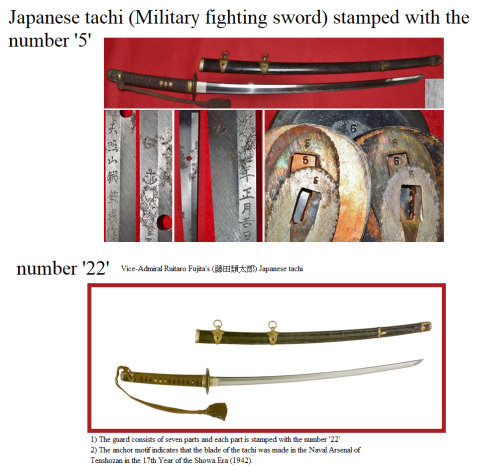|
1945 Surrender Ceremony - Government House |
| See https://gwulo.com/media/34196 for details |
This Japanese tachi (Military fighting sword), which belonged to Vice-Admiral Ruitaro Fujita 藤田類太郎 (active 1945) was surrendered to Rear-Admiral Sir Cecil Halliday Jenson (1892-1959) at the official surrender of Hong Kong to the British at Government House, on 16 September 1945.
| Navy Kamakura Tenshozan Forging Workshop |
| 「海軍・鎌倉天照山鍛錬所」 |
| number '22' - blade signed 'made at the tenshozan forge, june 1942' * |
| 銘文 (表) : 天照山鍛錬場作 , 銘文 (裏) : 昭和十七年六月 |
|
|
| * Sources : 'Military swords of Japan, 1868-1945' by Richard Fuller and Ron Gregory |
The hilt of the tachi consists of two pieces of wood joined together longitudinally to form the grip. The wooden grip is covered with ray-skin which has been stained black, and is bound with a piece of mid-brown woven cotton tape, twisted about itself and knotted immediately above the pommel (kabuto-gane). The grip was originally secured to the tang 32mm below the ferrule (fuchi) by a short bamboo rod, which is now missing. The gilt brass ferrule (fuchi) has a brass top and bears a running design of embossed single cherry blossoms and leaves executed on a stippled ground.
The gilt brass pommel (kabuto-gane) is stippled overall, and decorated with sprays of cherry blossoms executed in gilt copper relief. The gilt copper relief is of crested double ogee outline and is pierced to show the ray-skin beneath. A band passes round the handle bearing, on each side, at the mid point, a circular plaque decorated with a single cherry flower. Through the centre of the cherry flower is a copper sleeve instead of a metal loop (saru-te) for the sword knot to pass. The sword knot is made from a woven mid brown cord with two brown tassels and a brown cord Turk's head runner secured inside the hilt. On each side of the grip are the hilt pair (tsuka-ai) made in the form of the cherry flower repeated three times. The guard consists of seven parts and each part is stamped with the number '22', as is the end of the grip and the inside of the scabbard throat - presumably as an aid to assembling the tachi.
The slightly curved steel blade, has a ridge running nearly the whole length of the blade curving in conformity with the cutting edge to a medium curved edge point. The obverse of the flat-backed tang is engraved with an anchor motif. The anchor motif indicates that the blade of the tachi was made in the Naval Arsenal of Tenshozan in the 17th Year of the Showa Era (1942). A copper collar (habaki) is also fitted to the tachi. The black wooden scabbard is covered with ray-skin and has two gilt copper lockets and chape.
WPN1185 and WPN1184 were surrendered to Rear-Admiral Sir Cecil Halliday Jenson (1892-1959) at the official surrender of Hong Kong to the British at Government House, on 16 September 1945. The surrender followed occupation of the island by the Japanese for 3 years and 8 months, following invasion in 1941.
National Maritime Museum, Greenwich, London
ID: WPN1185


Comments
sword captured
A British soldier captured two of these swords:
https://gwulo.com/media/43178
Japanese Surrender - Presentation of Swords
In the top photo, Major-General Okada (in the centre) and Vice-Admiral Fujita (to his left in white) are standing to attention for the signing of the Instrument of Surrender.
In the bottom photo, Okada is presenting his sword to a British Naval Officer (name not known) after signing the Instrument of Surrender. Fujita is next to sign. Rear Admiral Cecil Halliday Jepson Harcourt is not in picture and is seated beside a table opposite Okada and Fujita. Harcourt will be presented with their swords by the British Naval Officer.